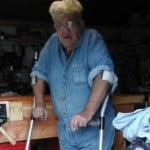How to install shelf in this night stand
Welcome! / Forums / General Woodworking Discussions / Projects / How to install shelf in this night stand
- This topic has 12 replies, 6 voices, and was last updated 8 years, 6 months ago by
 Frank Joseph.
Frank Joseph.
-
AuthorPosts
-

Hi all,
I’m currently working on a prototype for a nightstand and I’ve come across a bit of a design issue. It’s a bit hard to explain because I’ve already built most of the prototype, but also want to share what else I have in mind so you can see what I’m struggling with.
I’ve done some work in Sketchup to show you what I’m aiming for. I’m no Sketchup hero so it’s not complete.
In the zoomout picture you can see (most) of what I want to achieve. The top is missing, as is the drawer. What I’m struggling with is a shelf I want to install at the bottom, flush with the bottom apron.
Initially I thought I’d just cut housing joints in each of the 4 legs and I’ve actually cut these in my prototype. The zoomin image should show you what I mean.
Now the problem is fitting the shelf in such a way you don’t see gaps. This is quite challenging because you have to keep disassembling and assembling the joints to test the fit. And then you get it wrong…
Is there a better way of achieving this? Maybe use turn buttons to pull the aprons and the shelf together? Perhaps mortise the shelf into the aprons?
Something tells me there is a much simple solution out there. Anyone?
Wesley
Attachments:
You must be logged in to view attached files. 1 August 2015 at 11:36 am #129000
1 August 2015 at 11:36 am #129000I have a similar nightstand and the shelf just sits on the aprons. It is a tight fit so any gaps are minimal but it is NOT integral to the construction of the carcass. Just make sure the shelf is flat and stout. Mine is made out of 3/4″ oak.
With your design you may have to notch the corners of the shelf, but no big deal. This is by far the easiest way to handle a bottom shelf.

 2 August 2015 at 11:34 am #129009
2 August 2015 at 11:34 am #129009Correct NO attachments, resting on the aprons. Best type of wood for this is something stable. Straight grained. I used quarter sawn oak. And as I mentioned it needs to be flat so after thicknessing and glueing the panel together, flatten the wood. Then let it sit for a day or so and re-adjust its flatness.
By NOT attaching or making it integral to the carcass, you have no issues with the wood expanding or contracting due to humidity. So your gap will become bigger or smaller as the season changes.
If after some time one of the corners does raise up, you can attach a small piece of felt to the bottom of that corner so it does not wobble.
It looks like the front and back are open, so that the front and back aprons do not have grooves in them to receive the slats that are on the sides of the piece. If so, and maybe in all cases, you could run a groove on the face of the front and back aprons. Let’s say your bottom shelf is 3/4″ thick. Then you could do something like a 1/2″ groove ploughed 1/2″ down from the edge of the apron. Next, oversize the shelf by twice the depth of your groove and cut a rabbet along the front and back edge of the bottom. (You’ll see below this is really going to be a dado cut at the edge of the board.)
You would glue up your two sides independently, then assemble the front and back apron into one of them, slide the bottom into the grooves, then attach the second side. So, it is like a drawer bottom.
You’ll need to think about wood movement if the dimensions are big enough. If you run the grain left to right for the bottom, it will push deeper into the grooves as it expands and could push the mortise and tenons apart if you dimension everything “exactly,” e.g., to avoid a loose bottom. You could leave some extra room so that there is a gap between the tongue and the bottom of the groove, but then the bottom will rattle. If that’s a problem, then, if you run the grain front to back on the bottom, now the the bottom will expand side to side, sliding in the groove. Lengths don’t change much, so you could make things bottom out in the groove, make the rabbet a bit too wide, say by an 1/8, and cut the width of the bottom short by a 1/4 so that you’ll have a uniform 1/8″ gap all around the bottom. It will give good visual contrast. If you glue the center two inches of the groove to tack the bottom in place, it won’t rattle and will be able to expand side to side along the groove and into the gaps you left.
Edit: Guess that’s quite complicated compared to resting the bottom on top. 🙂 One thing to note is that, with that gap that I’m suggesting, it would be hard to get stain or dye into the gap when finishing and you’d probably need to do your color application prior to glue up. That may make some sense no matter how you do this, actually, especially if you are using dye and the gaps between the side slats are tight.

 16 September 2015 at 3:43 am #130541
16 September 2015 at 3:43 am #130541One way is to complete the joints on one side of the shelf, to two of the legs, assemble partailly with out the shelf, hold shelf in the assembled shelf area and pressing the completed side in against each leg and mark the exact size on each of the other joints…
If you are going to finish the night stand with 4 or 5 coats of a poly type finish, apply the finish to both sides of the shelf, in this way you can slow down the woods ability to take in moisture quickly.

Thanks David. I went for the ‘floating’ shelf option as suggested by Brett. Still working on the piece, though. The ‘filler’ pieces on the side (don’t know how to call them) were quite a lot of work, since I decided to cut overlapping rebates on them. This way they have space to expand a little, but it sure takes time without a rebate plane.
Will post a picture when finished. Any month now…
Wesley

Hi all,
The night stand is finished. I went with the “floating shelf” and I must say it worked out very well. The whole is not entirely square, which resulted in some gaps around the shelf.
Originally this was supposed to be a prototype but since it took me 3 months to make *and* my wife wants two, I decided this is a keeper.
To go for a rustic look it was painted white using Annie Sloan chalk paint. I diluted it with a little water in order to show some of the grain underneath.
The top was stained and then treated with Danish oil. I like how it turned out.
Now I need to make another one…
Wesley
Attachments:
You must be logged in to view attached files. 15 October 2015 at 6:19 pm #131367
15 October 2015 at 6:19 pm #131367Wesley,
I agree. The table turned out great. Your diluted chalk paint makes it looked like the wood was bleached (I guess that’s the term for it).
So simple, but the few touches in design makes it a wonderful piece, (the shaped legs and the bottom apron really make it).Nice design…
🙂Marilyn

 16 October 2015 at 2:57 pm #131387
16 October 2015 at 2:57 pm #131387Hi Weslee..
it looks very good your planing paid off big time on this,the paint is a good effect with the stain top, your idea of using dye would have worked well for the top but the stain is a winner.using the thinned paint was also a winner.
in total a winner good going
Frankj -
AuthorPosts
- You must be logged in to reply to this topic.
